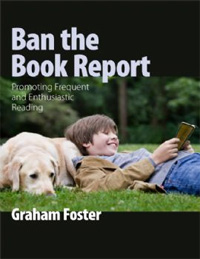| ________________
CM . . . . Volume XIX Number 25 . . . . March 1, 2013
excerpt:
In writing Ban the Book Report, Graham Foster has created a helpful resource for teachers to support students' critical thinking of texts they are reading. He has built on his experiences as a consultant, writer and workshop leader to create a practical book of reading response options complete with student exemplars, completion forms and student-friendly rubrics. This well-structured book also includes a short list of suggestions for further reading, locating additional resources and an index. Chapter 1 introduces readers to his approach and reasoning for developing these assignments which have all been tested by teachers in various classrooms. His advice to encourage students to read frequently and independently includes: a diverse collection of texts in school and classroom libraries; opportunities for readers of all ages to hear books read aloud; class time for reading self-selected texts, and time for students to talk and write about their personal and emotional responses. A side-note on page 8 states, "Response to independent reading must value meaning-making that includes emotional response and personal connections as well as thematic meaning and stylistic analysis." This reviewer and teacher would like to suggest changing that to state "all reading must value meaning-making . . . " A definite strength of the book is the thoughtful advice given at the start of each chapter in terms of when assignments work best for student responsiveness and what students have preferred in the past use of these assignments. The introduction to each chapter also includes suggestions for pre-teaching that may be needed to ensure students have the prior knowledge and skills necessary to be successful in completing the assignment. The handout page for each assignment describes the assignment, includes a three level rubric and a reflective space to self-assess and set a new reading goal. Two examples of student writing are provided with each assignment. These are of varying length and writing level, which is where the recommendation for grades 5-9 is derived from. Other exemplars for these assignment ideas could be created and thus expand the applicable grade level use. The collection of 20 reading response assignments include reading logs; oral and written responses; illustration and graphic representations; making connections to self, other texts and events; and responses to informational texts. While these assignments are promoted as useful for encouraging and reporting on independent student reading, they are valuable and appropriate to use to engage students in exploring mandatory or teacher chosen texts as well. The final chapter includes a collection of eight suggested assignments that can serve as a professional development activity for teachers to co-plan and complete. While this is an excellent idea, they can also be an opportunity for classroom teachers to write exemplars in front of and with their students (a la Regie Routman). Teachers could use these and other ideas to model responses to books they, themselves, have been reading independently. We can also celebrate reading by encouraging students to talk about the "good bits" (p. 11) in their books and to not require an assignment of any kind for some of their reading, a point not made in the book. Highly Recommended. Betty Klassen teaches in the Middle Years B. Ed. Program in the Faculty of Education at the University of Manitoba in Winnipeg, MB.
To comment
on this title or this review, send mail to cm@umanitoba.ca.
Copyright © the Manitoba Library Association. Reproduction for personal
use is permitted only if this copyright notice is maintained. Any
other reproduction is prohibited without permission.
NEXT REVIEW |
TABLE OF CONTENTS FOR THIS ISSUE
- March 1, 2013.
AUTHORS |
TITLES |
MEDIA REVIEWS |
PROFILES |
BACK ISSUES |
SEARCH |
CMARCHIVE |
HOME |
